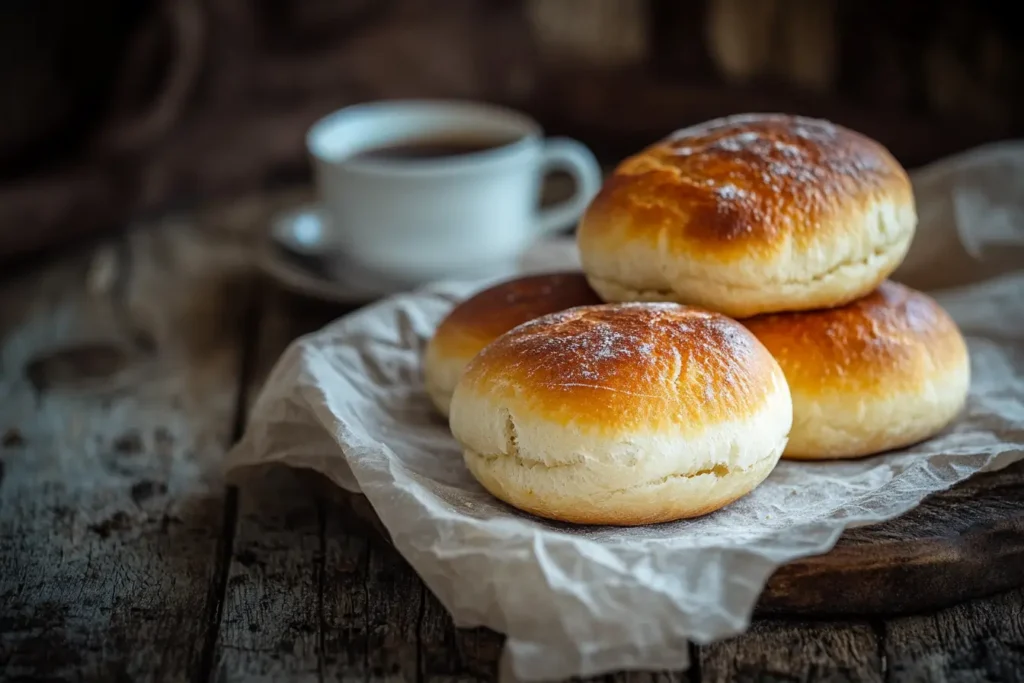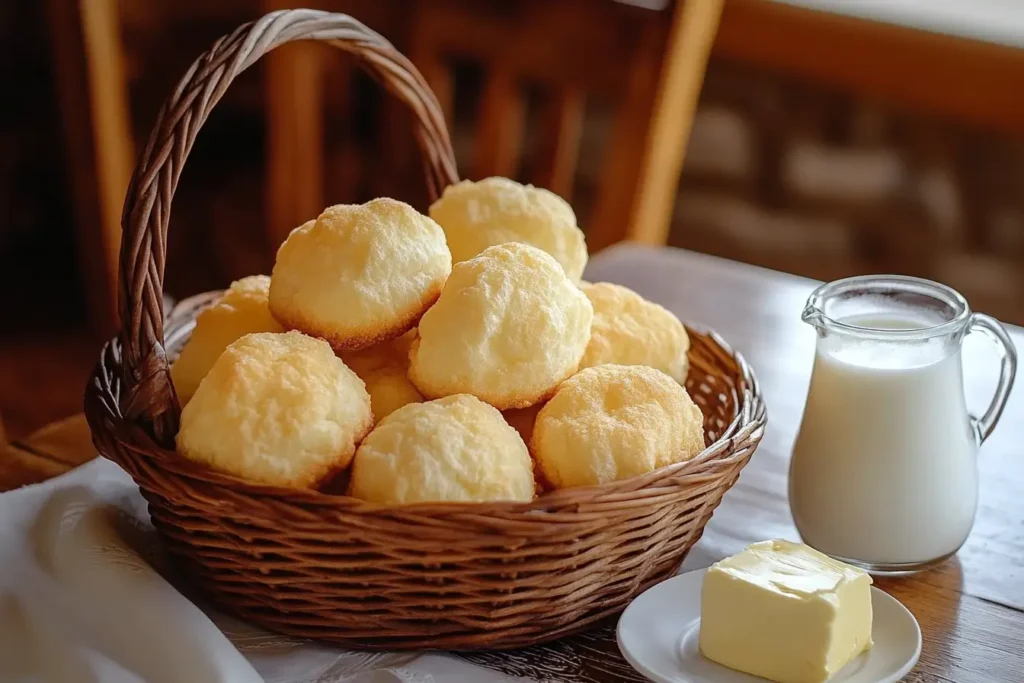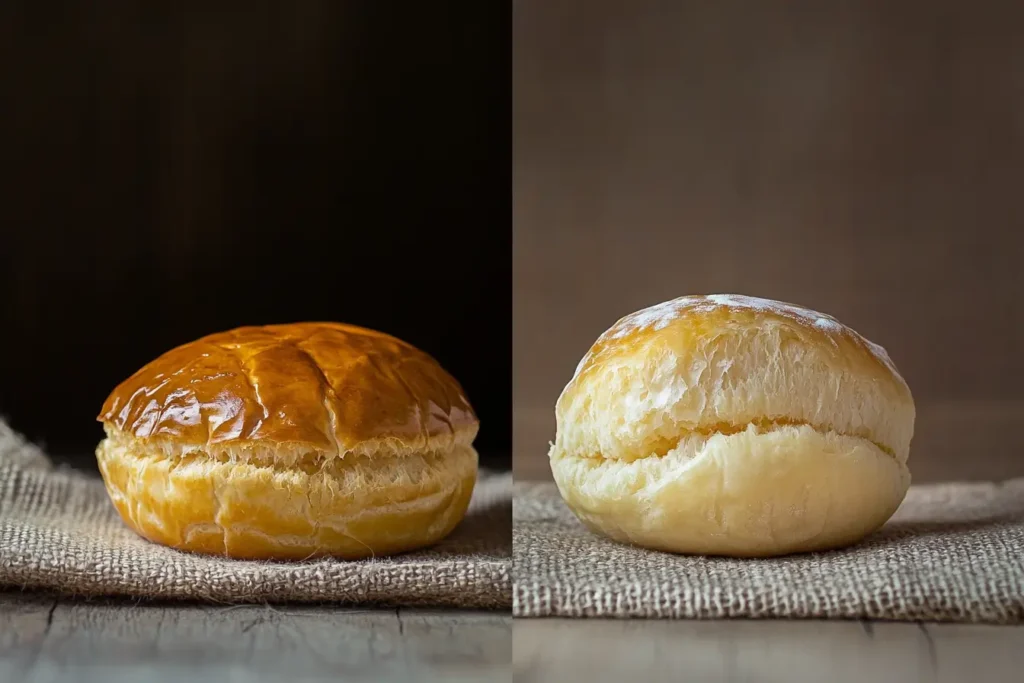
Colombian breads like pandebono and almojábana have captured the hearts of food lovers worldwide. People often enjoy these breads with a steaming cup of coffee or hot chocolate, making them a popular choice for breakfast or a snack. Although they share some similarities—both are cheesy, chewy, and utterly delicious—their subtle differences highlight their distinctiveness. Understanding what sets them apart reveals the rich culinary heritage of Colombia.
What is Pandebono?
Pandebono is a beloved Colombian bread with a distinctive cheesy flavor and soft, chewy texture. Many Colombian households serve it as a quick snack or breakfast option. Its simple yet flavorful recipe has turned it into a favorite in bakeries and cafes across Colombia and beyond.
Ingredients in Pandebono
The ingredients for pandebono are straightforward, emphasizing the natural flavors of cheese and corn. Here’s what typically goes into making it:
- Cassava starch (yuca flour): This gluten-free flour gives pandebono its unique chewy texture.
- Fresh cheese (queso costeño): A salty, crumbly cheese that blends perfectly into the dough. If unavailable, mozzarella or feta can be substituted.
- Cornmeal: Adds a mild, earthy flavor and a golden color to the bread.
- Eggs: Help bind the ingredients and give the bread its soft structure.
- Milk: Adds moisture and richness, ensuring a perfectly soft dough.
Origin and History
Pandebono originates from Colombia’s rich history, specifically in the Valle del Cauca region, where it quickly became a local specialty. The name reportedly derives from the Italian phrase “pane del bono,” which translates to “good bread.” Some stories claim Italian immigrants introduced the recipe, while others connect it to the creative use of locally available cassava starch and cheese. Despite the uncertainty surrounding its exact origin, pandebono holds a cherished place in Colombian culinary tradition.
How Pandebono is Made
Making pandebono is relatively simple and requires minimal preparation. Here’s an overview of the process:
- Mix the dry ingredients: Combine cassava starch, cornmeal, and a pinch of salt in a bowl.
- Add the cheese: Grate the fresh cheese and mix it into the dry ingredients.
- Incorporate the wet ingredients: Add eggs and milk gradually, mixing until a smooth, pliable dough forms.
- Shape the dough: Roll the dough into small, round balls or slightly flattened discs.
- Bake: Place the shaped dough on a baking tray and bake in a preheated oven at 375°F (190°C) for about 15-20 minutes, or until golden brown.
The end product is a delightfully soft bread that is perfect for breakfast or as a snack.
What is Pandebono?
Pandebono is a beloved Colombian bread known for its distinctive cheesy flavor and soft, chewy texture. It’s a staple in many Colombian households and is often served as a quick snack or breakfast option. Its simple yet flavorful recipe has made it a favorite in bakeries and cafes across Colombia and beyond.
Ingredients in Pandebono
The ingredients for pandebono are straightforward, emphasizing the natural flavors of cheese and corn. Here’s what typically goes into making it:
- Cassava starch (yuca flour): This gluten-free flour gives pandebono its unique chewy texture.
- Fresh cheese (queso costeño): A salty, crumbly cheese that blends perfectly into the dough. If unavailable, mozzarella or feta can be substituted.
- Cornmeal: Adds a mild, earthy flavor and a golden color to the bread.
- Eggs: Help bind the ingredients and give the bread its soft structure.
- Milk: Adds moisture and richness, ensuring a perfectly soft dough.
Origin and History
Pandebono’s origins are deeply rooted in Colombian history. This bread likely originated in the Valle del Cauca region, where it quickly became a local specialty. Its name supposedly comes from the Italian phrase “pane del bono,” which translates to “good bread.” Some stories claim that Italian immigrants introduced it, while others credit the use of locally available cassava starch and cheese. Regardless of the exact origin, Colombians have embraced pandebono as a cherished part of their culinary tradition.
How Pandebono is Made
Making pandebono is relatively simple and requires minimal preparation. Here’s an overview of the process:
- Mix the dry ingredients: Combine cassava starch, cornmeal, and a pinch of salt in a bowl.
- Add the cheese: Grate the fresh cheese and mix it into the dry ingredients.
- Incorporate the wet ingredients: Add eggs and milk gradually, mixing until a smooth, pliable dough forms.
- Shape the dough: Roll the dough into small, round balls or slightly flattened discs.
- Bake: Place the shaped dough on a baking tray and bake in a preheated oven at 375°F (190°C) for about 15-20 minutes, or until golden brown.
The result is a warm, fragrant bread with a slightly crisp exterior and a soft, cheesy interior.
What is Almojábana?
Almojábana is another traditional Colombian bread that shares similarities with pandebono but has distinct qualities that make it stand out. With its light and airy texture, almojábana offers a milder taste that pairs well with a variety of beverages and meals.
Ingredients in Almojábana
The ingredients for almojábana are similar to those of pandebono but with some variations:
- Cornmeal: A staple in both breads, but used in slightly different proportions for a softer texture.
- Queso campesino or fresh cheese: A less salty cheese than queso costeño, which contributes to the milder flavor.
- Milk or buttermilk: Adds a creamy richness and helps achieve a light texture.
- Butter: Provides a subtle flavor and contributes to the bread’s softness.
- Baking powder: Helps the bread rise, creating its signature fluffiness.
Origin and History
The history of almojábana can be traced back to Spain, where similar cheese-based breads were popular. When Spanish colonists arrived in Latin America, they brought this culinary tradition with them. Over time, the recipe evolved to incorporate local ingredients, resulting in the Colombian version we know today. Almojábana is particularly popular in the Cundinamarca and Boyacá regions, where it is often enjoyed with a hot beverage.
How Almojábana is Made
Although similar to pandebono, the preparation of almojábana has slight differences:
- Combine dry ingredients: Mix cornmeal, baking powder, and a pinch of salt in a bowl.
- Add the cheese: Grate queso campesino and mix it thoroughly with the dry ingredients.
- Incorporate wet ingredients: Add milk and softened butter to form a smooth, soft dough.
- Shape the dough: Form the dough into small, round balls or slightly flattened shapes.
- Bake: Bake at 350°F (175°C) for about 20 minutes, or until the tops are golden and the bread feels light and fluffy.
The end product is a delightfully soft bread that is perfect for breakfast or as a snack.

Key Differences Between Pandebono and Almojábana
Pandebono and almojábana are traditional Colombian breads made with similar ingredients, but they differ in texture, flavor, preparation methods, and regional variations. Understanding these distinctions enhances the appreciation of each bread’s unique qualities
Texture and Appearance
One of the most noticeable differences between pandebono and almojábana is their texture and appearance.
- Pandebono: Pandebono tends to have a slightly denser texture with a chewy, almost elastic consistency due to the use of cassava starch. It is typically shaped into small balls or rings and has a golden, slightly crispy exterior when baked.
- Almojábana: In contrast, almojábana is much lighter and softer, with a more delicate crumb. Its texture comes from the use of cornmeal and baking powder, which help it rise and create an airy structure. Almojábana often has a smoother, rounder appearance and a paler color compared to pandebono.
Flavor Profile
The flavor of pandebono and almojábana is another defining characteristic.
- Pandebono: This bread is known for its rich, tangy taste, which comes from the saltiness of queso costeño combined with the mild earthiness of cassava starch. The flavor is robust, making it an ideal pairing for strong beverages like coffee.
- Almojábana: Almojábana offers a more subtle flavor. The cheese in this bread is milder, and the addition of butter gives it a creamy richness. This makes almojábana versatile, as its flavor doesn’t overpower other dishes or drinks.
Regional Variations
Both pandebono and almojábana have regional variations that influence their preparation and popularity.

Health and Nutritional Value of Pandebono and Almojábana
While pandebono and almojábana are indulgent treats, they also offer nutritional benefits, especially for those seeking gluten-free or protein-rich options. However, like all baked goods, they are best enjoyed in moderation. If you’re curious about whether pandebono is a truly healthy choice, check out this in-depth guide on its nutrition, benefits, and tips.
Nutritional Breakdown
- Pandebono:
- Protein: High protein content comes from the cheese, making it a filling snack.
- Carbohydrates: The cassava starch is a significant source of carbohydrates, providing quick energy.
- Fat: Cheese and eggs add fat, contributing to the rich flavor but also increasing calorie content.
- Almojábana:
- Protein: Contains less cheese, so it has slightly lower protein content than pandebono.
- Carbohydrates: The cornmeal base provides complex carbohydrates, which release energy more slowly.
- Fat: The addition of butter adds a subtle richness but keeps the calorie count balanced.
Dietary Benefits
- Gluten-Free Options: Both breads are naturally gluten-free, making them suitable for people with gluten intolerances or celiac disease.
- Energy Boost: Thanks to their carbohydrate content, these breads provide a quick energy boost, making them ideal for breakfast or pre-workout snacks.
- Calcium and Protein: The cheese in both recipes is a great source of calcium and protein, supporting bone health and muscle repair.
Tips for Healthier Versions
If you’re looking to make a healthier version of pandebono or almojábana, consider these tips:
- Reduce Salt: Use low-sodium cheese to cut down on salt intake.
- Alternative Fats: Swap butter for healthier options like olive oil in almojábana recipes.
- Portion Control: Enjoy smaller servings to balance indulgence with nutritional goals.
Why Are Pandebono and Almojábana So Popular?
The cultural significance, taste, and versatility of pandebono and almojábana drive their widespread popularity. These breads represent more than just food; they symbolize Colombian identity and heritage.
Cultural Importance
In Colombia, bread connects people and fosters a sense of community. Families and friends frequently share pandebono and almojábana during breakfast or as an afternoon snack. Their warm and comforting nature firmly establishes them as staples of Colombian hospitality. They also play an integral role in traditional celebrations, festivals, and everyday joyful moments.
Global Popularity
As Colombian cuisine gains international recognition, pandebono and almojábana are increasingly available outside the country. Colombian bakeries in cities worldwide offer these breads to meet the demand of expatriates and curious food enthusiasts. Their gluten-free and cheesy qualities also make them appealing to those with dietary restrictions or unique tastes.
Frequently Asked Questions (FAQs)
Here are some common questions about pandebono and almojábana, offering additional clarity for those eager to learn more about these traditional Colombian breads.
Are Pandebono and Almojábana Gluten-Free?
Both breads are naturally gluten-free, making them an excellent choice for those with dietary restrictions. Pandebono combines cassava starch and cornmeal, which do not contain gluten. Similarly, almojábana avoids gluten by using cornmeal and other non-gluten-based ingredients.
Always check labels or recipes to ensure no cross-contamination occurs, especially with pre-made or store-bought options.
Which Is Easier to Make at Home?
The ease of preparation depends on the ingredients available and your familiarity with baking:
- Pandebono: Known for its forgiving dough and straightforward preparation. This makes it ideal for beginners.
- Almojábana: Requires a bit more precision as the dough’s texture is crucial for achieving its signature lightness.
For a deeper dive into traditional recipes, visit Indulge in Pandebono: The Heartwarming Taste of Colombia.
Can Pandebono and Almojábana Be Eaten for Breakfast?
Absolutely! These breads are breakfast staples in Colombia, often paired with coffee, hot chocolate, or aguapanela. Their cheesy, slightly salty flavor complements sweet or savory breakfast spreads, making them a versatile choice.
What Are the Best Accompaniments for These Breads?
Here’s how to enjoy them best:
- Pandebono: Delicious with guava paste, butter, or a slice of ham for a savory touch.
- Almojábana: Often enjoyed plain but pairs wonderfully with cream cheese or as an accompaniment to soups and stews.
Where Can I Find Pandebono and Almojábana Outside Colombia?
You’re in luck! These breads are increasingly available internationally, particularly in areas with large Latin American communities. Specialty stores and online platforms often sell frozen or ready-to-bake versions.
Conclusion
Pandebono and almojábana are two iconic breads that showcase the rich culinary traditions of Colombia. While they share some similarities in ingredients and preparation, their differences in texture, flavor, and regional popularity make each one unique. Whether you prefer the chewy, cheesy goodness of pandebono or the soft, airy lightness of almojábana, both breads offer a delicious taste of Colombian culture.
If you’re curious, why not try making them at home or visiting a Colombian bakery to sample them fresh? You might just discover your new favorite snack!
